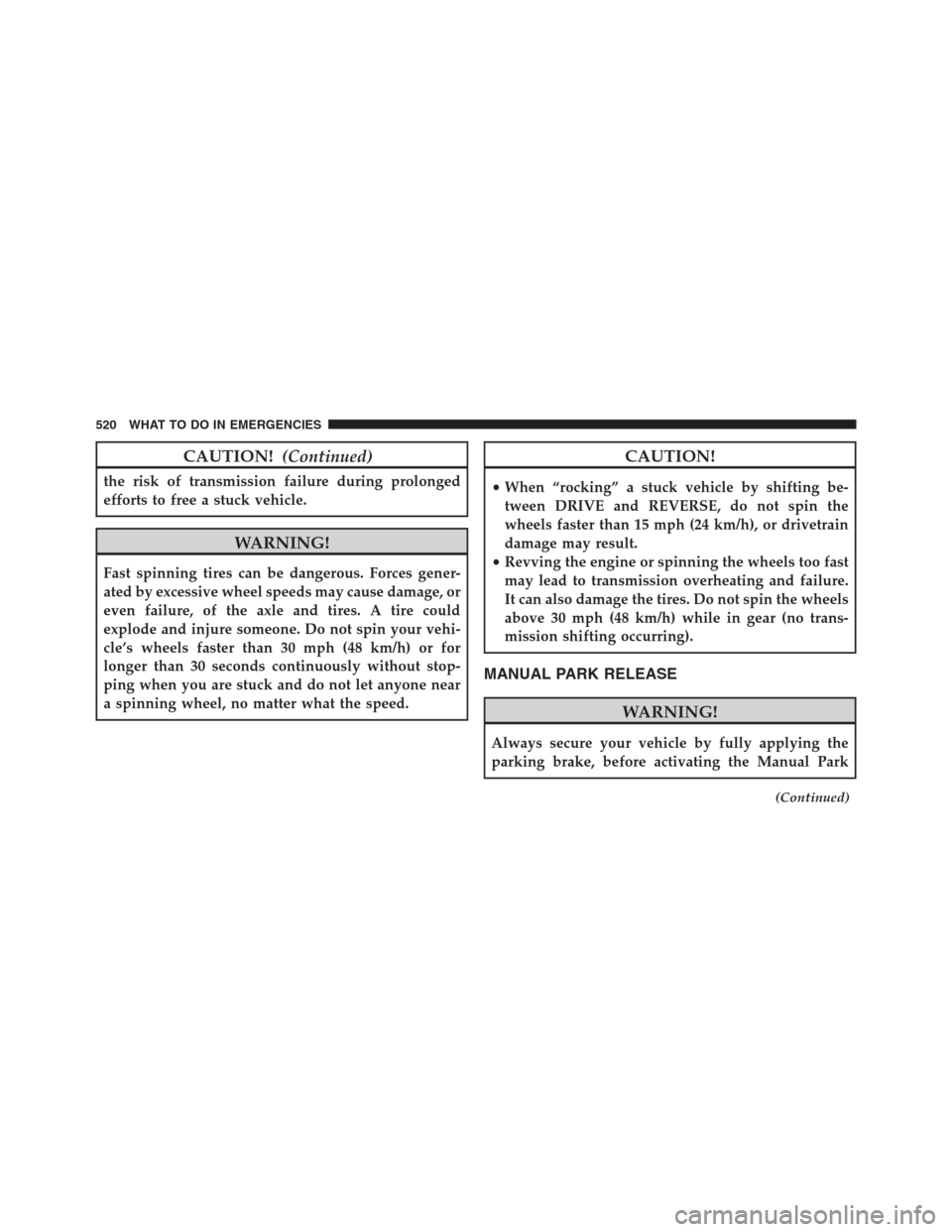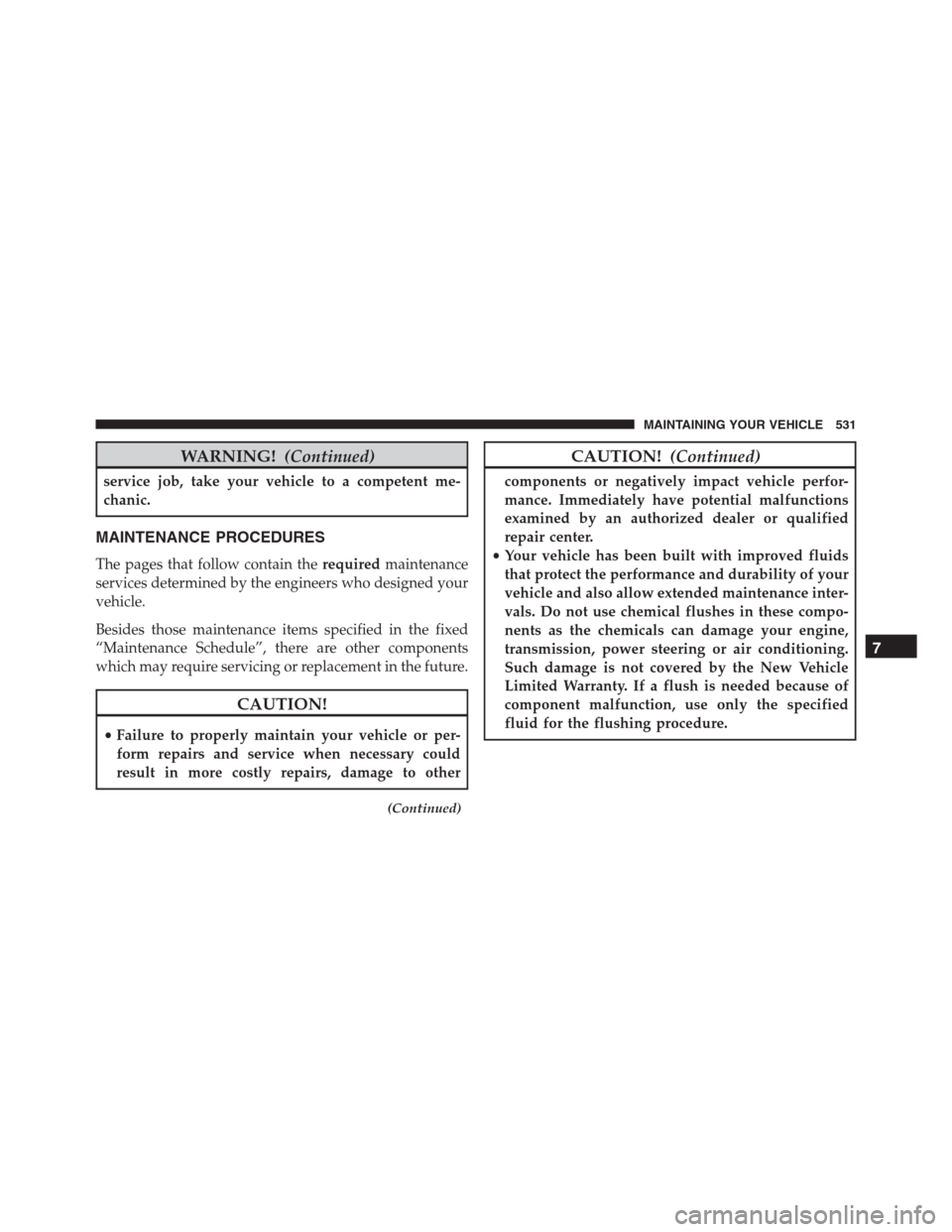Page 522 of 636

CAUTION!(Continued)
the risk of transmission failure during prolonged
efforts to free a stuck vehicle.
WARNING!
Fast spinning tires can be dangerous. Forces gener-
ated by excessive wheel speeds may cause damage, or
even failure, of the axle and tires. A tire could
explode and injure someone. Do not spin your vehi-
cle’s wheels faster than 30 mph (48 km/h) or for
longer than 30 seconds continuously without stop-
ping when you are stuck and do not let anyone near
a spinning wheel, no matter what the speed.
CAUTION!
•When “rocking” a stuck vehicle by shifting be-
tween DRIVE and REVERSE, do not spin the
wheels faster than 15 mph (24 km/h), or drivetrain
damage may result.
•Revving the engine or spinning the wheels too fast
may lead to transmission overheating and failure.
It can also damage the tires. Do not spin the wheels
above 30 mph (48 km/h) while in gear (no trans-
mission shifting occurring).
MANUAL PARK RELEASE
WARNING!
Always secure your vehicle by fully applying the
parking brake, before activating the Manual Park
(Continued)
520 WHAT TO DO IN EMERGENCIES
Page 524 of 636
4. While the metal latch is in the open position, simulta-
neously pull upwards on the tether strap until the
lever clicks and latches in the released position. The
transmission is now out of PARK and the vehicle can
be moved.CAUTION!
Closing the armrest while the Manual Park Release is
activated may damage the Manual Park Release
mechanism, the transmission, and/or the armrest.
Release LatchReleased Position
522 WHAT TO DO IN EMERGENCIES
Page 526 of 636
NOTE:Be sure to replace the cover by snapping it back
in place.
TOWING A DISABLED VEHICLE
The manufacturer requires towing your vehicle with all
four wheels OFF the ground using a flatbed.
If the key fob is unavailable, or the vehicle’s battery is
discharged, refer to “Manual Park Release” in this section
for instructions on shifting the transmission out of PARK
for loading onto a flatbed truck.
CAUTION!
•Towing this vehicle using any other method can
cause severe transmission and/or transfer case dam-
age.
•Damage from improper towing is not covered un-
der the New Vehicle Limited Warranty.
Stowed Position
524 WHAT TO DO IN EMERGENCIES
Page 528 of 636

▫Transfer Case........................565
▫Automatic Transmission................566
▫Appearance Care And Protection From
Corrosion...........................568
�FUSES..............................574
▫Power Distribution Center...............575
�VEHICLE STORAGE....................583
�REPLACEMENT BULBS.................583
�BULB REPLACEMENT..................585
▫High Intensity Discharge Headlamps (HID) — If
Equipped...........................585
▫Halogen Headlamps — If Equipped........586▫Front Turn Signal.....................587
▫Front Fog Lamps.....................587
▫Rear Tail, Stop, Turn Signal, And Backup
Lamps.............................588
▫Rear Liftgate Mounted Tail Lamp..........589
▫Center High-Mounted Stop Lamp (CHMSL) . .590
▫Rear License Lamp....................591
�FLUID CAPACITIES....................591
�FLUIDS, LUBRICANTS, AND GENUINE
PARTS ..............................592
▫Engine.............................592
▫Chassis............................593
526 MAINTAINING YOUR VEHICLE
Page 530 of 636

ONBOARD DIAGNOSTIC SYSTEM (OBD II)
Your vehicle is equipped with a sophisticated onboard
diagnostic system called OBD II. This system monitors
the performance of the emissions, engine, and automatic
transmission control systems. When these systems are
operating properly, your vehicle will provide excellent
performance and fuel economy, as well as engine emis-
sions well within current government regulations.
If any of these systems require service, the OBD II system
will turn on the “Malfunction Indicator Light (MIL).” It
will also store diagnostic codes and other information to
assist your service technician in making repairs. Al-
though your vehicle will usually be drivable and not
need towing, see your authorized dealer for service as
soon as possible.
CAUTION!
•Prolonged driving with the MIL on could cause
further damage to the emission control system. It
could also affect fuel economy and driveability.
The vehicle must be serviced before any emissions
tests can be performed.
•If the MIL is flashing, while the engine is running,
severe catalytic converter damage and power loss
will soon occur. Immediate service is required.
EMISSIONS INSPECTION AND MAINTENANCE
PROGRAMS
In some localities, it may be a legal requirement to pass
an inspection of your vehicle’s emissions control system.
Failure to pass could prevent vehicle registration.
For states that require an Inspection and Mainte-
nance (I/M), this check verifies the “Malfunction
528 MAINTAINING YOUR VEHICLE
Page 533 of 636

WARNING!(Continued)
service job, take your vehicle to a competent me-
chanic.
MAINTENANCE PROCEDURES
The pages that follow contain therequiredmaintenance
services determined by the engineers who designed your
vehicle.
Besides those maintenance items specified in the fixed
“Maintenance Schedule”, there are other components
which may require servicing or replacement in the future.
CAUTION!
•Failure to properly maintain your vehicle or per-
form repairs and service when necessary could
result in more costly repairs, damage to other
(Continued)
CAUTION!(Continued)
components or negatively impact vehicle perfor-
mance. Immediately have potential malfunctions
examined by an authorized dealer or qualified
repair center.
•Your vehicle has been built with improved fluids
that protect the performance and durability of your
vehicle and also allow extended maintenance inter-
vals. Do not use chemical flushes in these compo-
nents as the chemicals can damage your engine,
transmission, power steering or air conditioning.
Such damage is not covered by the New Vehicle
Limited Warranty. If a flush is needed because of
component malfunction, use only the specified
fluid for the flushing procedure.
7
MAINTAINING YOUR VEHICLE 531
Page 558 of 636

In unusual situations involving grossly malfunctioning
engine operation, a scorching odor may suggest severe
and abnormal catalyst overheating. If this occurs, stop
the vehicle, turn off the engine and allow it to cool.
Service, including a tune-up to manufacturer’s specifica-
tions, should be obtained immediately.
To minimize the possibility of catalytic converter dam-
age:
•Do not shut off the engine or interrupt the ignition,
when the transmission is in gear and the vehicle is in
motion.
•Do not try to start the engine by pushing or towing the
vehicle.
•Do not idle the engine with any spark plug wires
disconnected or removed, such as when diagnostic
testing, or for prolonged periods during very rough
idle or malfunctioning operating conditions.Cooling System
WARNING!
•When working near the radiator cooling fan, dis-
connect the fan motor lead or turn the ignition
switch to the OFF position. The fan is temperature
controlled and can start at any time the ignition
switch is in the ON position.
•You or others can be badly burned by hot engine
coolant (antifreeze) or steam from your radiator. If
you see or hear steam coming from under the hood,
do not open the hood until the radiator has had
time to cool. Never try to open a cooling system
pressure cap when the radiator is hot.
Coolant Checks
Check the engine coolant (antifreeze) protection every 12
months (before the onset of freezing weather, where
556 MAINTAINING YOUR VEHICLE
Page 568 of 636

Drain
First remove fill plug, then remove drain plug. Recom-
mended tightening torque for drain and fill plugs is 15 to
25 ft lbs (20 to 34 N·m).
CAUTION!
When installing plugs, do not overtighten. You could
damage them and cause them to leak.
Selection Of Lubricant
Use only the manufacturer’s recommended fluid. Refer
to “Fluids, Lubricants, and Genuine Parts” in “Maintain-
ing Your Vehicle” for further information.
Automatic Transmission
Selection Of Lubricant
It is important to use the proper transmission fluid to
ensure optimum transmission performance and life. Useonly the manufacturer’s specified transmission fluid.
Refer to “Fluids, Lubricants, And Genuine Parts” in this
section for fluid specifications. It is important to maintain
the transmission fluid at the correct level using the
recommended fluid.
NOTE:No chemical flushes should be used in any
transmission; only the approved lubricant should be
used.
CAUTION!
Using a transmission fluid other than the manufac-
turer ’s recommended fluid may cause deterioration
in transmission shift quality and/or torque converter
shudder. Refer to “Fluids, Lubricants, And Genuine
Parts” in this section for fluid specifications.
566 MAINTAINING YOUR VEHICLE